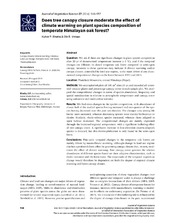| dc.description.abstract | Question: We ask if there are significant changes in plant species composition after 20 yr of documented temperature increase (~1 °C), and if the temporal changes are different in closed temperate oak forest compared to semi-open canopy. Answers to these questions may indicate if climate warming and/or canopy closure, controlled by land-use regime, is the main driver of any documented compositional changes in the forest between 1993 and 2013. Location: Phulchoki Mountain, central Himalaya (Nepal). Methods: We resampled 64 plots of 100 m2 after 20 yr and recorded all terrestrial vascular plants and percentage canopy cover in each sample plot. We analysed the compositional changes in terms of species abundance, frequency and spatial translocation in relation to atmospheric temperature and canopy cover using univariate and multivariate statistics. Results: We find clear changes in the species composition, with abundance of almost half of the studied species having increased and one-quarter of the species having decreased over the past two decades. The changes vary among life forms: trees increased, whereas decreasing species were mainly herbaceous or shrubs. Similarly, shade-tolerant species increased, whereas those adapted to open habitat decreased. The compositional changes are mainly explained through the increased regional temperature, with a significant buffering effect of tree canopy cover. A significant increase in low-elevation (warm-adapted) species is detected, but this thermophilization is only found in the semi-open forest. Conclusions: Fine-scale temporal changes in the temperate oak forests are mainly driven by macroclimate warming, although change in land-use regime also has a profound direct effect by governing canopy closure that, in turn, moderates the effect of climate warming. Tree canopy cover governs the relative abundances of different species based on their adaptive characteristics, such as shade tolerance and life-form traits. The magnitude of the temporal vegetation change would therefore be dependent on both the degree of regional climate warming and forest canopy closure. | en_US |

